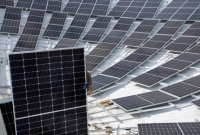Solar power is set to dominate global electricity markets within the next few decades, and may have already reached an "irreversible tipping point,” according to a study published this week in Nature. The study finds that solar adoption will continue apace barring any major policy shifts geared at disrupting it.
"If you don't put any additional policy in your system, you still get a switch or a flip,” says Femke Nijsse, a lecturer at the University of Exeter who focuses on energy systems modeling and was the lead author on the study. "We currently have a fossil fuel-dominated system and without additional policies, we arrive at a state that's dominated mostly by solar.”
Researchers plugged data from 70 global regions into an energy simulation model to forecast how 22 different technologies, from geothermal energy to coal, are likely to be deployed through 2060. In 72% of the simulations, they found that solar made up the majority of global power generation in 2050.
Solar power is playing an important role in countries’ plans to meet emissions-reduction goals set by the Paris Agreement, and as wind-power projects contend with rising costs. Many countries, including the U.S., U.K. and Canada, have pledged to reach net zero by 2050, a goal that will require overhauling the energy sources powering their electricity grids.
In addition to being a cleaner choice, solar is getting cheaper. The levelized cost of solar-generated electricity — i.e. the cost per megawatt that makes it worth installing — ranges from $42 to $48, compared with $74 for coal, according to BloombergNEF. Jenny Chase, a lead solar analyst at BloombergNEF who was not involved in the study, says those costs will keep falling. "Every time you double the cumulative amounts of solar-power modules that the human race has made, we bring the cost down about 29%,” she says.
It’s not all sunny skies ahead, however. Rapidly transitioning to solar power without preparation can lead to economic and industrial impacts on communities, the study notes, especially those with stakes in the fossil fuel industry. The researchers found that up to 13 million people worldwide risk losing their livelihoods to renewables adoption. Fluctuations in weather and sun exposure also mean that overreliance on solar could cause grid instability and vulnerability. That may still be an improvement on fossil fuels overreliance, but it’s "not a scenario where you want to go,” Nijsse says. "You need policies to steer it towards a more sustainable scenario.”
To steer solar’s rise, governments should invest in other renewable energy sources, including wind and hydro, and help affected communities with retraining and development programs, according to Nijsse. The industry will also have to overcome barriers that include supply chain constraints around critical metals and minerals, and a lack of financing in developing countries.
"Grid expansion is necessary to add more solar and wind and that is investment,” Chase says. "It's not clear in many countries who's going to pay for it or where it should be built.”
But the study’s findings are promising, especially if adoption trends continue and costs keep declining, according to Chase. "We're trying to transition the entire world's energy system here,” she says. "The fact that at least now it's cheap to replace a lot of the power system with solar is really good news.”



















With your current subscription plan you can comment on stories. However, before writing your first comment, please create a display name in the Profile section of your subscriber account page.